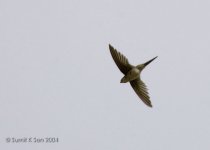rb_stern said:
I would be interested to know what camera and lens settings people have found most useful for flying and for stationary birds, with the d70 (or d100, which probably has similar choices) and the 80-400VR. In particular, do you use the auto, aperture priority or program mode, and what type of auto focus setting have you found most helpful?
As I have been using mine now for the grand total of 2 days, I am at the very bottom of the learning curve.
I use my 80-400mm. VR with my D100, and have found the combination to be WONDERFUL. Don't let anyone tell you that the lens is not sharp, has poor build quality, etc. The only real shortcoming is the relatively slow AF (someday they will come out with an AF-S model, I hope). It's a terrific product.
That said, I use the lens with the aperture priority setting. I set the aperture as "stopped down" as I can while still achieving an adequately fast shutter. And of course, I can adjust using the variable ISO setting. I have found that up to ISO 1000, the noise level with properly exposed photos is quite acceptable. Even with VR, I like to use a shutter speed of 1/640 or faster. Maybe I'm just peculiarly shaky.
I also like to avoid using the lens wide open, as in typical fashion, the performance of the lens will lose just a bit of sharpness at this setting. But even 1/3 of a stop "down" (i.e., f6.3), the lens performance improves a lot.
By f9 or so, the lens is optimally sharp.
Actually, I most commonly use the "S" focus setting, and this is particularly true if the bird is not moving. With the "C" setting the lens will sometimes search a bit even after focusing, and this can be annoying. But of course, if the bird is moving I use "C."
People claim that tracking flying birds with this lens is very difficult because of the slow AF. It's certainly not as easy as with the new, fast, AF-S lenses, but the trick is to (while using the "C" setting) capture the bird in the center of the frame where the (+) focus indicator is located. Once you have locked onto the bird, keep it in line with the focus indicator and it will remain in focus as you track it. This takes a bit of practice, but it's a skill fairly easily mastered.
The last thing I'll mention here is that with this combination of camera and lens re bird photography, It's VERY important that you get accustomed to using your exposure compensation function in a judicious way. The fact is that 'auto' exposures of birds, even if you spot meter, will give you poor exposures in many cases, particularly if the bird is white or very dark. For white birds against a darkish background you MUST be used to underexposing at LEAST one full stop, and for black birds you need to open up your exposure by at least 0.7 stops, sometimes more. Trial and error is the key here, and after some practice and some bracketing you will get a feel for the compensation settings you need to make.
Good luck!





